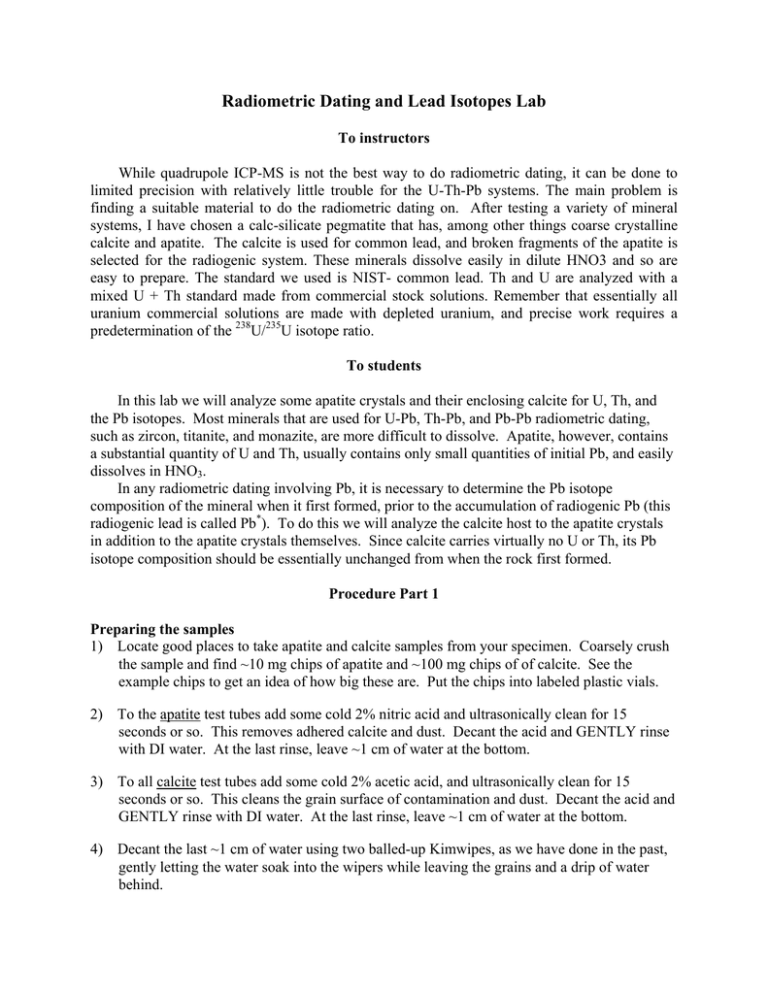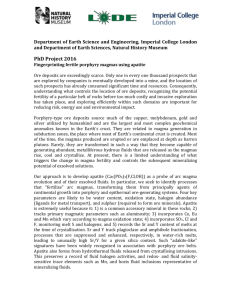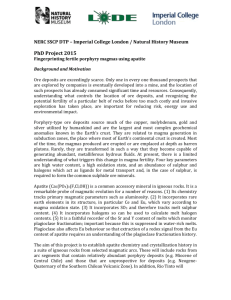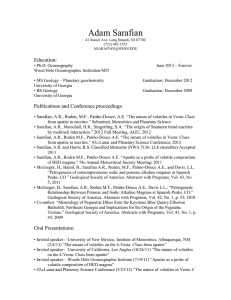Radiometric Dating and Lead Isotopes Lab
advertisement

Radiometric Dating and Lead Isotopes Lab To instructors While quadrupole ICP-MS is not the best way to do radiometric dating, it can be done to limited precision with relatively little trouble for the U-Th-Pb systems. The main problem is finding a suitable material to do the radiometric dating on. After testing a variety of mineral systems, I have chosen a calc-silicate pegmatite that has, among other things coarse crystalline calcite and apatite. The calcite is used for common lead, and broken fragments of the apatite is selected for the radiogenic system. These minerals dissolve easily in dilute HNO3 and so are easy to prepare. The standard we used is NIST- common lead. Th and U are analyzed with a mixed U + Th standard made from commercial stock solutions. Remember that essentially all uranium commercial solutions are made with depleted uranium, and precise work requires a predetermination of the 238U/235U isotope ratio. To students In this lab we will analyze some apatite crystals and their enclosing calcite for U, Th, and the Pb isotopes. Most minerals that are used for U-Pb, Th-Pb, and Pb-Pb radiometric dating, such as zircon, titanite, and monazite, are more difficult to dissolve. Apatite, however, contains a substantial quantity of U and Th, usually contains only small quantities of initial Pb, and easily dissolves in HNO3. In any radiometric dating involving Pb, it is necessary to determine the Pb isotope composition of the mineral when it first formed, prior to the accumulation of radiogenic Pb (this radiogenic lead is called Pb*). To do this we will analyze the calcite host to the apatite crystals in addition to the apatite crystals themselves. Since calcite carries virtually no U or Th, its Pb isotope composition should be essentially unchanged from when the rock first formed. Procedure Part 1 Preparing the samples 1) Locate good places to take apatite and calcite samples from your specimen. Coarsely crush the sample and find ~10 mg chips of apatite and ~100 mg chips of of calcite. See the example chips to get an idea of how big these are. Put the chips into labeled plastic vials. 2) To the apatite test tubes add some cold 2% nitric acid and ultrasonically clean for 15 seconds or so. This removes adhered calcite and dust. Decant the acid and GENTLY rinse with DI water. At the last rinse, leave ~1 cm of water at the bottom. 3) To all calcite test tubes add some cold 2% acetic acid, and ultrasonically clean for 15 seconds or so. This cleans the grain surface of contamination and dust. Decant the acid and GENTLY rinse with DI water. At the last rinse, leave ~1 cm of water at the bottom. 4) Decant the last ~1 cm of water using two balled-up Kimwipes, as we have done in the past, gently letting the water soak into the wipers while leaving the grains and a drip of water behind. 5) Put the vials on their sides in the drying oven at 105°C to dry for ½ hour or so. Caps should be left in to dry too. 6) Weigh dried grains into numbered plastic centrifuge tubes. Record the weight in your lab notebook AND on the centrifuge tube. 7) Add 10 g of “diluting solution“ to the centrifuge tube. This is done with a weight-calibrated pipette. Ideally these dilution steps should all be done on a weight basis, but for our work a weight-calibrated pipette is sufficiently accurate. This diluting solution contains 2% HNO3 and 200 ppb of Tl as an internal standard. 8) Securely cap the vials and put in the drying oven set to 50°C until dissolved. This should take only minutes for the calcite but several hours for the apatite. Diluting the samples, same for apatite and calcite 1) Label a new pair of test tubes, one for your apatite and one for your calcite. 2) Add 0.25 ml of the first dissolved mineral solution and 9.75 g of “diluting solution”. Again this will be done using a weight-calibrated pipette. This diluting solution is similar to the first, but with 1% HNO3 and without the Tl internal standard. 3) Analyze the blank, standard, apatite, and calcite solutions for 203Tl, 204Pb, 105Tl, 206Pb, 207Pb, 208 Pb, 232Th, and 238U. Reanalize the blank and the standard between each set of samples. Radiometric Dating and Lead Isotopes Lab Procedure Part 2, concentration calculations 1. The data are given in a spreadsheet on the Geochemistry web page: Pb-Pb_data. The data values are in ion counts per second. The ICP-MS computer has already corrected the data for detector dead time. 2. Blank correction (remove background). Each analysis of standard, calcite, and apatite needs the blank subtracted away. Subtract the average blank from all standard, calcite, and apatite analyses for all isotopes. We can ignore the blanks henceforth. 3. Internal standard correction (sensitivity drift). For each row, normalize each each isotope signal to a 205Tl value of 100. This is essentially the signal for each element corrected for instrument sensitivity drift using the 205Tl internal standard as the sensitivity reference. In doing this, all 205Tl isotope values become 100 and all other isotopes are changed accordingly. 4. You will notice that the 203Tl isotope values are not all the same. In part, this is due to counting uncertainty derived from counting statistics and from ion source and transmission instabilities. 205Tl/203Tl ratios are therefore not exactly equal to the actual value of 2.3871 (Handbook of Chemistry and Physics). In addition to counting uncertainty, the ICP-MS instrument also has an inherent mass bias which, in this part of the mass spectrum, is biased toward lower sensitivity at higher masses. We measured both Tl isotopes so we can correct for this intrinsic mass bias. 5. Mass bias correction 1. Instrument sensitivity varies with mass, becoming progressively poorer above mass ~115. Raw isotope signals therefore need to be corrected for this mass bias so measured isotope ratios represent their actual ratios. Our mass bias correction for lead is the procedure of Longerich et al. (1987). For each standard, apatite, and calcite calculate a lead mass bias correction factor C: C = 2.3871 / (205Tl / 203Tl). Once the correction factors are calculated for each standard, apatite, and calcite, you can ignore all Tl isotopes for the rest of this lab. 6. Mass bias correction 2. This correction factor can now be used to correct the Pb isotope values only for mass bias for each standard, apatite, and calcite: 204 Pb = 204Pbo * C0 206 Pb = 206Pbo * C1 207 Pb = 207Pbo * C1.5 208 Pb = 208Pbo * C2 where 20XPbo = the original value for the lead signal at that isotope (from Part 2, Step 4). The mass bias correction cannot be applied to U and Th; they are too far away to reliably extrapolate the mass bias correction from 203Tl and 205Tl. Simply carry down the U and Th values from the previous block. 7. Isotope concentrations in solution. You now have the (normalized and mass bias corrected) signal for isotopes in the standard and sample (calcite and apatite) solutions, and also the standard concentrations for each isotope. The concentrations (in ppb) for each isotope in the calcite and apatite solutions is calculated as follows, using only its immediately preceeding standard: Sample concentration = (standard concentration/standard signal) * sample signal Calculate the sample concentrations for each isotope. Note the standard concentrations remain blank, as we are done with them. 8. Dilution factor correction. You have calculated the concentrations of isotopes in solution. What you really want is the concentration of each isotope in the original calcite and apatite crystals. What you need to do is multiply the concentration of each element in solution by the dilution factor used to prepare the solutions from the original solid crystals. A. The first dilution was done when the mineral was dissolved. As you may recall, you added 10.00 g of acid solution to the mineral, so the first dilution factor was: DF1 = (10.00 g + crystal weight) / crystal weight. EXAMPLE: If the calcite crystal weighed 0.13 g then the dilution factor DF1 is 77.9. B. The second dilution was done when the dissolved mineral solution was diluted just prior to analysis. 0.25 g of the first solution was added to 9.75 g of a diluting solution made of dilute HNO3. This dilution factor is: DF2 = (0.25 g + 9.75 g) / 0.25 g = 40. C. The combined dilution factor for the original calcite crystal is: DF1 * DF2 = DFtotal EXAMPLE: 77.9 * 40 = 3117. Calculate DFtotal for each apatite and calcite crystal. Note again that we are no longer interested in any of the standards. 9. Isotope concentrations in the crystals. The concentration of each element in each crystal is equal to its concentration in solution multiplied by its combined dilution factor. Many of the resulting concentrations are annoyingly large, so convert concentrations in the crystals from ppb to ppm. 10. 235U calculation. Calculate the values for 235U in our natural calcite and apatite samples by the equation: 235 U = 238U / 137.89 137.89 is the natural 238U/235U isotope ratio. We did not analyze for 235U because it turns out to be considerably more accurate for us to calculate it. In any case, essentially all uranium sold commercially, including our element standards, are made of depleted uranium from which most fissionable 235U has been removed. The commercial uranium is left over from the production of 235U-enriched uranium for reactors and nuclear weapons. The factor for this depletion is already included in to the uranium standard concentration given in the spreadsheet. Natural uranium contains ~0.720% 235U. Ours contains only ~0.28% 235U because of extraction of 235U. This vary from lot to lot. 11. Element calculations from isotopes. In a block to the right of the dilution factor corrected concentrations (ppm), calculate the final element concentrations for each apatite and calcite solution: Th is done, because Th has only one important isotope Pb = the sum of the four Pb isotopes. U = the sum of the two U isotopes. Procedure Part 3, age calculations Decay scheme U → 206Pb* 235 U → 207Pb* 232 Th → 208Pb* 238 Natural parent isotope abundance 99.27% 0.72% 100% T½ years λ 4.4683*109 0.7038*109 14.010*109 1.5513*10-10yr-1 9.8486*10-10yr-1 4.9475*10-11yr-1 1. Age dating setup. On a new spreadsheet page, copy over (by links) the isotope concentrations (ppm) for each apatite and calcite sample from Part 2, Steps 9 and 10, above. Do not include the Tl isotopes or any blank or standard information. Do include 204Pb, 206Pb, 207 Pb, 208Pb, 232Th, 235U, and 238U concentrations in the crystals. 2. Group all the calcites together and all the apatites together by deleting empty rows. 3. Look at the samples and decide if any should be discarded. There may be evidence of sample contamination or experimental mishap. Delete these samples but justify doing so in your writeup. 4. No particular calcite is physically associated with any particular apatite sample. Average all of the acceptable calcite analyses (excluding bad samples, see Step 3). 5. For each apatite and the average calcite, divide each isotope concentration by its ISOTOPE ATOMIC WEIGHT to get back molar proportions for each isotope. Isotope atomic weights can be gotten from the Handbook of Chemistry and Physics, and from various web resources. This gives us atomic proportions that we need for age calculations. 6. Each apatite represent a single radiometric clock system. You will calculate ages using four radiometric clocks for each apatite. The calcite represents common Pb, which is an initial contaminant in the apatite and needs to be corrected for. We know it is an initial contaminant because 7. Simple clock ages. Use the following equations to calculate three independent ages for each of the apatite based on the 206Pb*/238U, 207Pb*/235U, and 208Pb*/238Th radiometric clocks. ⎡ ⎛ 206 Pb ⎞ ⎤ ⎛ 206 Pb ⎞ ⎟ ⎟ ⎢⎜ ⎥ −⎜ ⎜ 204 Pb ⎟ ⎜ 204 Pb ⎟ ⎢ ⎥ ⎠ ⎝ ⎠ ⎝ 1 apatite calcite ⎢ ⎥ + = ln 1 t 206 / 238 ⎥ ⎛ 238U ⎞ λ 238 ⎢⎢ ⎟ ⎜ ⎥ 204 ⎜ Pb ⎟⎠ apatite ⎢ ⎥ ⎝ ⎣ ⎦ ⎡ ⎛ 207 Pb ⎞ ⎤ ⎛ 207 Pb ⎞ ⎟ ⎟ ⎢⎜ ⎥ −⎜ ⎜ 204 Pb ⎟ ⎜ 204 Pb ⎟ ⎢ ⎥ ⎠ calcite ⎠ apatite ⎝ ⎝ 1 ⎢ ⎥ + = ln 1 t 207 / 235 ⎥ ⎛ 235U ⎞ λ 235 ⎢⎢ ⎜ ⎟ ⎥ ⎜ 204 Pb ⎟ ⎢ ⎥ ⎝ ⎠ apatite ⎣ ⎦ ⎡ ⎛ 208 Pb ⎞ ⎤ ⎛ 208 Pb ⎞ ⎟ ⎟ ⎢⎜ ⎥ −⎜ ⎜ 204 Pb ⎟ ⎜ 204 Pb ⎟ ⎢ ⎥ ⎠ calcite ⎠ apatite ⎝ ⎝ 1 ⎢ ⎥ + = ln 1 t 208 / 232 232 ⎢ ⎥ ⎛ ⎞ λ 232 ⎢ Th ⎟ ⎜ ⎥ ⎜ 204 Pb ⎟ ⎢ ⎥ ⎝ ⎠ apatite ⎣ ⎦ 8. Pb/Pb clock ages 1. Calculate the 207Pb*/206Pb* ratio in each apatite using the following equation: ⎛ ⎜ ⎜ ⎝ ⎡⎛ ⎢⎜ 207 ⎢ ⎜⎝ Pb ⎞⎟ =⎢ 206 Pb ⎟⎠ radiogenic ⎢ ⎛⎜ ⎢ ⎢ ⎜⎝ ⎣ ⎤ ⎛ 207 Pb ⎞ Pb ⎞⎟ ⎟ ⎥ −⎜ 204 Pb ⎟⎠ apatite ⎜⎝ 204 Pb ⎟⎠ calcite ⎥ ⎥ 206 ⎥ ⎛ 206 Pb ⎞ Pb ⎞⎟ ⎟ −⎜ ⎥ 204 Pb ⎟⎠ apatite ⎜⎝ 204 Pb ⎟⎠ calcite ⎥ ⎦ 207 9. Pb/Pb clock ages 2. Calculate the 207Pb*/206Pb* isotopic age of each apatite. Set up the following equation that will calculate the 207Pb*/206Pb* isotope ratio at any time t using the following equation: ⎛ λ t ⎞ ⎛ 207 Pb ⎞ 1 ⎜ e 235 − 1 ⎟ ⎜ ⎟ = ⎜ ⎟ ⎜ 206 Pb ⎟ ⎝ ⎠ radiogenic 137.88 ⎜⎝ eλ238t − 1 ⎟⎠ This transendental equation cannot be algebraically solved for t, but it can be solved by substituting values for t to result in the measured value of 207Pb*/206Pb* in the apatites. Use trial and error (very tedius), or the Excel Tools/Goal Seek function to automatically search for the correct value of t for each apatite. I will show you in class how to do this. 9. Concordia intercept age 1. Prepare a 206Pb*/238U vs. 207Pb*/235U concordia graph. Calculate the concordia curve using the equations below and plot it on a spreadsheet (X-Y graph). Modify the X and Y axis scales so that the curve does not extend much beyond the apatite data points, to be calculated below. I suggest a time range of 0 to 1.0 billion years and steps of 50 million years. Since this is a smooth function, it can be fitted with a spline curve. 207 X = Pbradiogenic 235 U 206 Y= Pbradiogenic 238 U = e λ235t − 1 = eλ238 t − 1 10. Concordia intercept age 2. Calculate the 207Pb*/235U and 206Pb*/238U ratios for all of the apatite samples and plot them on the concordia diagram. For the apatite crystal the 206 Pb*/238U and 207Pb*/235U ratios are calculated using the following equations. ⎛ X =⎜ ⎜ ⎝ ⎛ Y =⎜ ⎜ ⎝ 207 206 Pbradiogenic ⎞ ⎟ = 235 ⎟ U ⎠ apatite Pbradiogenic ⎞ ⎟ = 238 ⎟ U ⎠ apatite ⎛ ⎜⎜ ⎝ 207 ⎛ 207 Pb ⎞ Pb ⎞ ⎜ ⎟ ⎟ − 204 Pb ⎟⎠ apatite ⎜⎝ 204 Pb ⎟⎠ calcite ⎛ 235U ⎞ ⎜⎜ 204 ⎟⎟ ⎝ Pb ⎠ apatite ⎛ ⎜⎜ ⎝ 206 ⎛ 206 Pb ⎞ Pb ⎞ ⎟ ⎟ ⎜ − 204 Pb ⎟⎠ apatite ⎜⎝ 204 Pb ⎟⎠ calcite ⎛ 238U ⎞ ⎜⎜ 204 ⎟⎟ ⎝ Pb ⎠ apatite 11. Concordia intercept age 3. a. If the data points are mostly above the concordia curve, this represents uranium gain at some time in the past. The age of the crystal can’t be determined, but the age of uranium gain can be estimated. Fit a linear regression line through the apatite data points on the concordia graph, and extend the line so that it crosses the concordia curve (using options in the trendline menu). The crossing point is the best estimate of the time of uranium gain. This is a minimum age of the crystal. b. If the data points are mostly below the concordia curve, this represents Pb* loss at some time in the past. In general, without other constraints, it is usually wisest to assume modern lead loss. Fit a linear regression line through the apatite data points on the concordia graph, and forc the line through the origin (using options in the trendline menu). Where this line crosses the Concordia curve is the best estimate of the age of the mineral. c. If the data points straddle the Concordia curve, fit a linear regression line to the apatite data points. Where the regression line crosses the Concordia curve is the age of the apatite. 12. Lastly, calculate the atomic weight of lead in the average calcite and in each apatite. You need to use the lead isotope atomic weights, and the molar proportions of the lead isotopes in average calcite and in each apatite. This is a simple mixing equation. The atomic weight of lead in the standard is 207.215, and the atomic weight of lead given by the Periodic Table of the Elements (Sargent-Welch) is 207.2. How do your samples differ? Why doesn’t it make sense for the Periodic Table of the Elements to list the lead isotope atomic weight to more than one decimal place? Content of the Report The final report should contain: 1) A table of the isotope and element concentrations in each of the apatite and calcite crystals deemed acceptable. 2) A table of the lead atomic weight in each apatite and in the average calcite. 3) A table containing the calculated ages for all apatite samples based on the 206Pb*/238U, 207 Pb*/235U, 208Pb*/232Th, and 207Pb*/206Pb* radiometric clocks, averages and two standard deviation precision calculations. This table should also include the estimated age based on the Concordia-cord intercept in your figure. 4) A figure with the 207Pb/206Pb Concordia curve, the plotted apatite data, and the cord through the apatite data. All parts should be appropriately labeled, including the intercept age. 5) A discussion of the age dates: are they concordant or discordant? What clocks are most and least precise? What is the best estimate of the age of the apatite? Reference Longerich, H.P., Fryer, B.J. and Strong, D.F., 1987, Determination of lead isotope ratios by inductively coupled plasma-mass spectrometry (ICP-MS). Spectrochimica Acta, v. 42B, nos. 12, p. 39-48. Notes Things needed for this lab High-purity HNO3. 100 ml volumetric flasks for diluting. Pipettes. 1000 ppm Eu standard solution. Autosampler test tubes. • • • Prep cannot all be done in one hour. Do in lab. Drying takes ½ hour in a 105 degree oven. Dissolution in 2% nitric acid takes ~24 hours at 50°C, with occasional shaking. Original source: Instrumentation lab exercises, Pedagogy web page Kurt Hollocher Geology Department Union College Schenectady, NY 12308 U.S.A.



